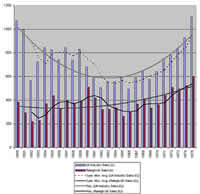|
2.2
1950-68
In 1951, Raleigh produced more than a million cycles. But between 1950 and 1962, as increasingly prosperous consumers abandoned the cycle in favour of the car, cycle sales in the UK halved. This led Raleigh in 1958 to resume moped production and later to launch a motor scooter. More significantly, during this period Raleigh acquired two major rival groups: Triumph and Three Spires in 1954, and BSA (including New Hudson and Sunbeam) in 1957. Raleigh itself was then taken over by Tube Investments (TI), whose British Cycle Corporation owned Phillips, Hercules, Norman and Sun. The effect of these mergers was that Raleigh’s sales figures showed a slight upward trend during most of the 1950s.The TI take-over followed a collaborative venture with Raleigh in South Africa. In 1960, TI bought all Raleigh shares, then handed over the British Cycle Corporation to Raleigh management. Suddenly, TI-Raleigh had 75% of the UK market. Unfortunately, it was a market that was rapidly shrinking.
In spring 1960 Raleigh, having stopped making quality lightweight cycles at Nottingham, bought Carlton Cycles, a respected hand-built racing cycle specialist company based nearby at Worksop.
Raleigh urgently needed to increase volume sales to the man and woman in the street. In October 1960, a licensing agreement was drawn up allowing Raleigh to make the new, small-wheeled, unisex, dual-suspension Moulton bicycle. Production was scheduled to commence in November 1961 but in September, Raleigh imposed a moratorium: Leslie Roberts, Raleigh’s incoming managing director, did not believe the Moulton could yield a reasonable profit.
Alex Moulton therefore built his own factory and started delivering Moultons to the trade in March 1963. The new machine was an immediate success, and most production had to be farmed out to Fisher & Ludlow, a subsidiary of the British Motor Corporation.
In March 1964, Raleigh showed Moulton the prototype RSW16: an unsprung small-wheeled shopping bike that was well equipped, more robust and cheaper than the Moulton. It was unclear whether the RSW breached Moulton’s patents and in June 1964 Raleigh sought a production licence for the Moulton bicycle. Alex Moulton was prepared to licence an unsprung F-frame small-wheeler, provided the genuine Moulton could be sold through Raleigh dealers. Negotiations continued into the autumn of 1964 and included the possibility of Raleigh buying the Moulton cycle operation outright, or Raleigh buying Moulton bicycles badged as Raleighs, or Raleigh taking over Moulton’s marketing. None of these options came to fruition.
By mid 1965, Moulton was producing more than 1,000 units a week. The new cycle, and the interest it created in cycling as a stylish, modern and practical mode of transport, had arrested the steep post-war decline in UK cycle sales. However, Raleigh was seeing little benefit, except from the Sturmey-Archer hubs it sold to Moulton. Indeed, since the TI take-over, Raleigh’s sales had dropped by a staggering 9%. In addition, other cycle makers such as Dawes and Royal Enfield were introducing small-wheelers to cash in on the Moulton boom. Therefore, in July 1965, Raleigh launched the RSW16 with an unprecedented £100,000 of publicity (= more than £1m today).
The RSW16 proved commercially successful, going into MkII and MkIII versions and selling more than 100,000 units in its nine-year production run. Scaled-down juvenile versions, such as the RSW14, also sold well. However, the Wisp, a moped based on the RSW16 and launched in spring 1967, proved a commercial failure.
Launch of the RSW sparked a trade war between Raleigh and Moulton. By 1967, both were suffering. Despite a 40% increase in sales since launch of the RSW16, Raleigh’s profits for the previous year were down 8% and Moulton was losing money unsustainably. In late July 1967, Moulton Bicycles Limited was bought by Raleigh, who retained Alex Moulton as a consultant.
In 1968, but with relatively little publicity, Raleigh introduced the Twenty. This long-lived H-frame small-wheeler was destined to become for a while the company’s biggest selling model and remained in production for some 16 years. At one time or another, it was sold under almost every brand name owned by Raleigh

Click the chart to enlarge
Raleigh UK sales plotted against sales for the whole UK cycle industry, 1950-75. The polynomial curves show the 'big picture' for the whole period; the 3-year moving average curves give a more precise view.
 ............................................. .............................................
|





